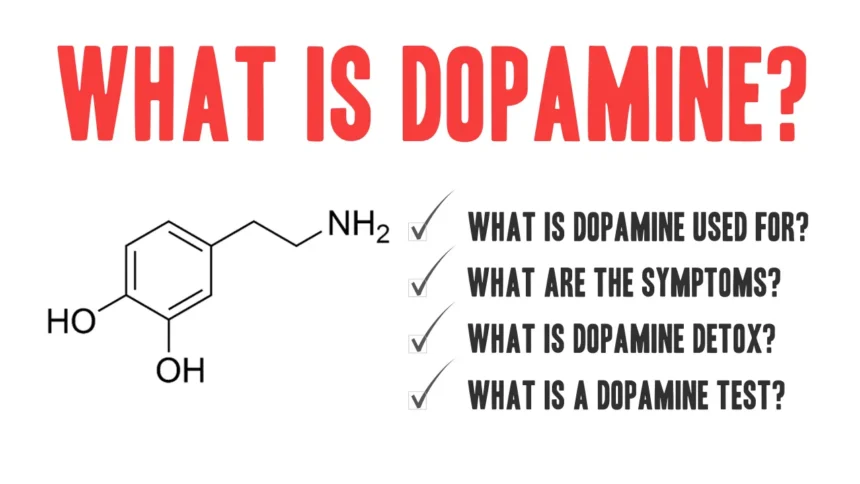What is dopamine?
Dopamine is a type of neurotransmitterA chemical messenger who transmits signals in the brain and other areas of the body. It is produced in several regions of the brain, mainly substantia nigra And Ventral Tegmental Zone (VTA). Dopamine plays a central role in motivation, movement, reward, learning, mood and pleasure.
It acts both as a neurotransmitter (in the brain) and a neurohormone (affecting blood pressure and hormonal function in the body).
What is dopamine for?
Dopamine is essential for a wide range of functions, including:
- Movement control: Help coordinating smooth voluntary movements (crucial in Parkinson’s disease).
- Reward and motivation: Triggers pleasure and strengthens behavior (for example, eating, exercising, socializing).
- Mood regulation: Has an impact on motivation, concentration and emotional response.
- Attention and learning: Involved in cognitive processes and memory.
- Endocrine function: Inhibits the secretion of prolactin and affects the regulation of appetite.
What are the symptoms of dopamine deficiency?
Dopamine deficiency occurs when dopamine production or sensitivity to receptors is altered. This can lead to neurological and psychological symptoms.
The current signs include:
- Fatigue or lack of motivation
- Mood or apathy
- Poor concentration or attention (common in ADHD)
- Reduced pleasure (Anhedonia)
- Muscle stiffness or tremors
- Weight changes
- Memory problems
- Sleep disturbances
Note: A serious deficiency is observed in disorders such as Parkinson’s diseasewhere dopamine producing neurons degenerate.
What are the symptoms of excess dopamine?
Too much dopamine, especially in specific brain circuits, can cause:
- Anxiety or agitation
- Insomnia
- Impulsiveness or addictive behavior
- Delirious thought or hallucinations (seen in psychotic disorders)
- Risks
- Mania (as we see in bipolar disorder)
Excess dopamine is often involved in schizophrenia And Psychosis induced by drugs.
Dopamine diseases
Dopamine deregulation is linked to several psychiatric and neurological conditions:
| Disorder | Dopamine role |
|---|---|
| Parkinson’s disease | Loss of neurons producing dopamine in substantia nigra |
| Schizophrenia | Dopamine overactivity in certain brain areas (mesolimbic route) |
| ADHD | Reduction of the transmission of dopamine in the prefrontal cortex |
| Depression | The signaling of altered dopamine can contribute to low motivation and pleasure |
| Bipolar disorder | Dopamine fluctuations linked to manic and depressive episodes |
| Dependence | Substances consumption increases dopamine in the reward circuit, strengthening behavior |
What is the detoxification of dopamine?
“”DOPAMINE DetoxIs a popular and non -scientific term to temporarily avoid dopamine trigger activities (for example, social media, junk food, video games) to reset the brain reward system and reduce impulsive behavior.
What he really does:
- Help Shake
- Encourage conscious behavior
- Reset Basic reward sensitivity
- Can help concentration, productivity and mental clarity
Although it is not a literal detoxification of dopamine (which the body naturally regulates), practice can improve habits by reducing compulsive behaviors.
What is a dopamine test?
A dopamine measures dopamine levels or its metabolites (for example, homovanillic acid) In the blood, urine or cerebrospinal fluid. These tests are generally used to assess:
- Pheochromocytoma (a rare tumor)
- Neuroendocrines tumors
- Parkinson research
- Monitoring of psychiatric drugs (rare)
These tests are not used regularly To diagnose mood or behavioral problems such as ADHD or depression.
The relationship between dopamine and serotonin
Dopamine and serotonin are the two neurotransmitters but serve different functions:
| Dopamine | Serotonin |
|---|---|
| Involved in motivation,, rewardAnd pleasure | Regular mood,, sleep,, appetiteAnd social behavior |
| Increase in dependence, schizophrenia | Linked to depression, anxiety disorders |
| Promotion Behavior led by objectives | To strenghten contentment and stability |
| Low levels: apathy, fatigue, low motivation | Low levels: sadness, anxiety, bad sleep |
The two systems interact and often influenceThis is why drugs like Ssri (for serotonin) and dopamine agonists Can be used together in mood or neurological disorders.
Frequently asked questions about dopamine
Q: Can food increase dopamine naturally?
A: Yes. Foods rich in tyrosine—A precursor of amino acid with dopamine – Include eggs, dairy products, soy, fish and bananas.
Q: Does exercise increase dopamine?
A: Yes. Regular physical activity improves the release of dopamine and sensitivity to receptors, in particular Aerobic exercise.
Q: Is low dopamine the same as depression?
A: Not exactly. Dopamine deficiency contributes to Anhedonia and low motivationBut depression also involves serotonin and other neurotransmitters.
Q: Are there natural ways to support dopamine levels?
A: Yes, sleep, protein intake, physical activity, sun exposure and overstimulation avoidance can support the balance of dopamine.
References
- Volkow ND, et al. The role of dopamine in motivation, pleasure and dependence. American Journal of Psychiatry. 2009; 166 (1): 29–36.
- Schultz W. Dopamine Signals for the value and risk of reward: basic and recent data. Behavioral and brain functions. 2010; 6 (1): 24. https://doi.org/10.1186/1744-9081-6-24
- Grace AA. Dopamine system dysregulation in the pathophysiology of schizophrenia and depression. Nature reviews neuroscience. 2016; 17 (8): 524–532. https://doi.org/10.1038/nrn.2016.57
- Salamone JD, Correa M. The mysterious motivation functions of mesolimbic dopamine. Neuron. 2012; 76 (3): 470–485. https://doi.org/10.1016/j.neuron.2012.10.021







